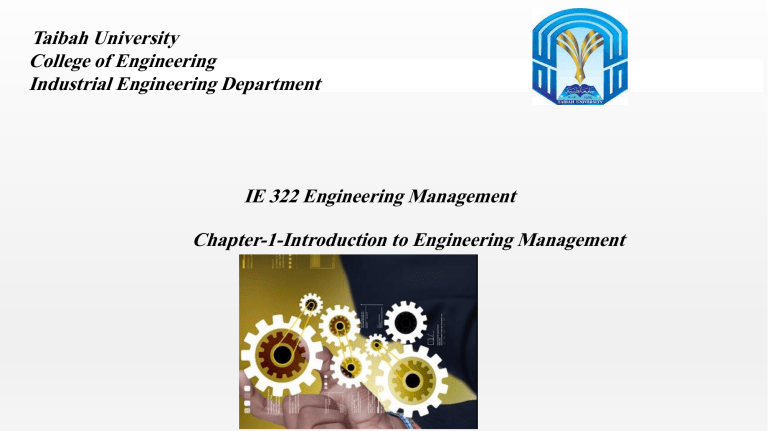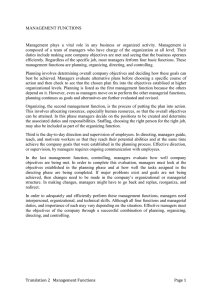
Taibah University College of Engineering Industrial Engineering Department IE 322 Engineering Management Chapter-1-Introduction to Engineering Management Introduction to Engineering Management • What is engineering? • What is management? Introduction to Engineering Management Engineering Management The profession in which a knowledge A set of activities (including planning of and the mathematical and natural decision making, organizing, sciences gained by study, experience, leading and control) directed at an and practice is applied with judgement organization's to financial, physical and informational) develop ways to utilize, the resources aim economically, the materials and forces with of nature for the benefit of mankind. organizational goals in an efficient and effective manner. of (human, achieving Introduction to Engineering Management Management McFarland’s four uses of the word management: 1. An organizational or administrative process “He practices good management”; 2. A science, or discipline “He is a management student”; 3. The group of people running an organization “Management doesn’t really believe in quality”; and 4. An occupational career “I want to get into management.” Introduction to Engineering Management Management Management is getting things through others, Management needs: • Objective • Resources, • Methods, • Organization setting, • People Introduction to Engineering Management Management Definitions 1. The work of creating and maintaining environments in which people can accomplish goals efficiently and effectively. 2. The process of achieving desired results through efficient utilization of human and material resources. 3. The process of reaching organizational goals by working with and through people and other organizational resources. 4. The process of acquiring and combining human, financial, informational, and physical resources to attain the organization’s primary goal of producing a product or service desired by some segment of society. Introduction to Engineering Management Management is all about managing the organization resources to meet its goals efficiently Take-Away Managers are the people who are responsible for management/ supervision Introduction to Engineering Management Management Levels White Collar 8 Introduction to Engineering Management Management Levels First line Mangers Middle Managers Top Managers • Foreman, supervisor, or section chief • Supervise nonmanagers • Carry out the plans of higher management. • Make short-range operating plans. • Assign day-to-day tasks and supervise the work that is done and evaluate the performance of the workers. Plant manager, division head, chief engineer, or operations manager. Supervise first-line managers Make plans of intermediate range to achieve the goals set by top management Establish departmental policies. Chairman of the board, president, executive vice president, or chief executive officer (CEO). Responsible for defining the vision, mission, and objectives of the enterprise. They establish criteria for and review long-range plans. They evaluate the performance of major departments. Introduction to Engineering Management Levels of Management Introduction to Engineering Management Managerial skills Focus by level skills needed Conceptual Top management Ability to solve long term problems and view the total organization as an interactive system Interpersonal Middle management Ability to work effectively Technical Supervisory management Ability to use tools, apply specialized knowledge and manage process and techniques Robert Katz Three Managerial Skills Introduction to Engineering Management Managerial Functions by Henry Fayol • Planning • Organizing • Directing • Controlling Planning Setting Goals Controlling Monitor, Measure & Correct Organizing Structure of Roles Leading Coordination & Motivation Introduction to Engineering Management Planning involves selecting missions and objectives and the actions to achieve them; it requires resources allocation and decision making Organizing is that part of management that involves establishing a structure of roles for people to fill in an enterprise. Leading is influencing people to strive toward the achievement of organization and group goals. Controlling is the measurement and correction of activities of subordinates to ensure that events conform to plans. Introduction to Engineering Management What is Engineering Management? Engineering Management is the art and science of planning, organizing, allocating resources, and directing and controlling activities that have a technological component. Engineering Management is designing, operating, and continuously improving purposeful systems of people, machines, money, time, information, and energy by integrating engineering and management knowledge, techniques, and skills to achieve desired goals in technological enterprise through concern for the environment, quality, and ethics. Introduction to Engineering Management What is Engineering Management? Engineering Management is the discipline addressed to making and implementing decisions for strategic and operational leadership in current and emerging technologies and their impacts on interrelated systems. Introduction to Engineering Management Engineering Management Domain Introduction to Engineering Management • Example areas of engineering management area are: Product development Manufacturing Construction Design engineering Industrial engineering Technology Production • Successful engineering managers typically require training and experience in business and engineering to: • Operating effectiveness • Problem solving and operations improvement Introduction to Engineering Management Need for Engineers in Management High technology enterprises make a business of doing things that have never been done. Since success factors are often technical, the engineer is the best capable of recognizing them. Engineering managers can best evaluate the capability of technical personnel when they apply for positions and rate their later performance.








